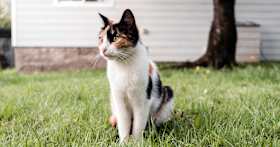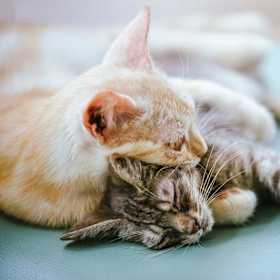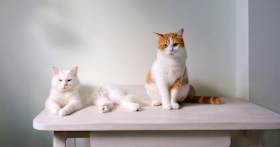Should I Adopt a Long- or Short-Haired Cat?
You’re ready to adopt a feline, but is a short- or long-hair the way to go? We weigh the pros and cons.
You’re ready to adopt a feline, but is a short- or long-hair the way to go? We weigh the pros and cons.
by Janelle Leeson, | June 6, 2024

Nils Jacobi / Shutterstock
Whether you’re a first-time cat parent or an experienced one, choosing between adopting a short-haired or a long-haired cat can be tough. Sure, both types make wonderful companions, but you’ll want to consider your lifestyle and preferences, too. Do you mind regular grooming? Are allergies a concern? This rundown of the pros and cons of longhair versus shorthair cats will help you decide which may be the right one for you.
When you’re having trouble deciding if you’d prefer a long-haired cat, consider these important factors.
Floof factor: If you have a soft spot for cuddling a fluffy friend, there’s no denying that a long-haired cat’s flowing fur is irresistible. But here’s the thing: Not all cats are fans of cuddling. When visiting shelter cats, ask the staff which long-haired cats seem to enjoy being handled the most.
Potentially less shedding: Believe it or not, longhairs can sometimes shed less than short-haired cats. “Short-haired cats usually have more fur follicles than longer-haired cats,” explains Daniel Lioy-Ryan, PhD, cat groomer and co-owner of Cats in the City in Portland, Oregon. All that short hair might look less obvious, but they’re still shedding just as much, and sometimes more.
Unique looks and personalities: Long-haired cats come in all sizes, colors, and personalities. You might come across shelter cats who are mixed or even purebred. Ragdolls, for example, have long color-point fur and are known for their laid-back personalities (they melt into your arms like a doll!). On the other hand, the massive Maine Coon comes in all fur colors and is typically chatty and playful.
A cat's life experiences play a major role in shaping their personality. Talk to the shelter staff about the cat’s background and how they’ve been doing at the shelter.
More brushing: Long-haired cat breeds such as those related to the Persian have a double coat — a thinner top coat and a dense undercoat. To prevent matting and tangles, these fluffy cats need to be brushed daily. If daily brushing isn’t your thing, some longhairs have a single coat of silky fur without a dense undercoat. These breeds, like Birman, typically only need to be brushed once a week to keep their fur tangle-free.
Potential for rear-end messes: Long-haired cats, especially as they age, might need your help grooming around their rear end. Poop, pee, or litter can sometimes get stuck in their fur. Regular grooming checks and occasional trims around their bum can help prevent this.
More hairballs: Cats spend up to 50 percent of their day grooming. Their tongue grabs and removes loose dirt and fur. Most of this fur is swallowed and ends up in the litter box. However, sometimes the fur clumps together, forming a hairball that’s then regurgitated. While both longhairs and shorthairs can get hairballs, long-haired cat breeds tend to get more.
More noticeable shedding: It’s a myth that all long-haired cats shed more than short-haired cats. Long fur is simply more noticeable on clothes, the floor, and furniture. Regular brushing will help, but a good vacuum cleaner will be your other best friend.
Shorthairs have their pros and cons, too.
Fewer hairballs: Short-haired cats can still get hairballs, but the shorter fur is less likely to form dense clumps compared to longhair breeds. Regular brushing is the best defense against hairballs, no matter your cat’s coat length.
Less noticeable shedding: Short strands tend to blend in more with clothes and furniture compared to long fur. However, remember that some short-haired breeds, like the British Shorthair, can shed a lot.
Easy grooming: Regular brushing (once a week or so) helps remove loose fur and prevent hairballs, but it’s a quicker process than managing a long coat.
Wide breed variety: You’re bound to spot a few longhairs at your local shelter, but you’re more likely to spot a cat with short hair. That’s because long hair is a recessive genetic trait. So a cat needs two copies of the longhair gene to have long fur, whereas a short-haired kitten only needs one copy of the shorthair gene. Estimates suggest that only about 10 percent of domestic cats in the United States have long hair.
Unique looks and personalities: Like long-haired cats, no two short-haired cats are exactly alike.
Shedding: As Lioy-Ryan explains, short-haired cats can shed quite a bit — sometimes more than long-haired cats. It might be less noticeable than long hair, but nonetheless clings to clothes and your furniture.
Less cuddle factor: This is clearly subjective, but some find that shorthairs don’t provide the same level of sink-your-hands (and face) squishiness that longhairs do. But hair length isn’t associated with a cat’s personality. If you’d like a cuddly cat, shelter staff and fosters can point you in the right direction.
Coat length isn’t an indicator of a cat’s personality. Instead, focus on a cat’s history, interaction with people and pets, and overall temperament.
Below are some popular cat breeds known for their long or short-haired coats. While breed can influence a cat’s personality, life experiences play a bigger role. Most cats in the United States are lovable mixed breeds, with only 16 to 18 percent being pedigreed felines. So don’t limit your search.
You can search Adopt a Pet for cats filtered by coat length (short, medium, long, or hairless), coat color, age, sex, and other characteristics that are important to you.
Unfortunately, there is no such thing as a hypoallergenic cat breed, because cat allergies are triggered by a protein found in their saliva, urine, and dander – not just in their fur. However, opting for a cat breed that sheds less fur can help reduce allergy symptoms, along with a dedicated cleaning regime. Low-shedding cat breeds to consider include:
Single-coat longhairs, like the Balinese and Ragdoll
Low-shedding shorthairs, such as the Burmese, Oriental Shorthair, and Russian Blue
Hairless cat breeds, including Sphynx, Cornish Rex, and the Devon Rex
Choose a cat that has a personality that fits your lifestyle. For instance, kittens are playful bundles of joy who require more attention and supervision than older cats. Adult cats come in a wide range of personalities, and senior cats often prefer quiet companionship but may have age-related medical needs.
If you’re unsure what sort of cat is right for you, consider becoming a foster pet parent. Fostering allows you to provide temporary care for a cat in need while you gain insight into what it’s like to have a cat.

Janelle Leeson is a Portland, Oregon-based freelance writer. Her work has been featured in magazines such as Inside Your Dog’s Mind, Inside Your Cat’s Mind, and Paw Print, as well online at Insider Reviews, NBC Select, Shop Today, PetMD, and Daily Paws. She has two adventure cats, a flock of urban chickens, and a soon-to-be-husband who doesn’t mind housing the occasional foster cat — or five.

Adoption Advice

Adoption Advice

Adoption Advice

Adoption Advice
Preparing for a kitten’s first vet visit. Learn about what you can expect from a vet visit and what you should do to ensure it goes smoothly.

Adoption Advice
Life with an FIV+ cat isn’t so different after all

Adoption Advice
Don’t want your adoption application to get rejected? Learn how to increase the chances of an approval.

Adoption Advice
Biases and preferences can get in the way of adopting a perfectly adorable cat. Here’s a look at the least adopted cats, and why they tend to languish in shelters.

Adoption Advice
Ready to welcome a new feline friend? Here’s how to make sure your home is ready for their arrival.

Adoption Advice
Adopting a kitty is a major commitment, but it doesn’t have to be a scary one. Here’s how to know when you’re ready to be the best pet parent ever.

Adoption Advice
Adopting a gray-colored kitty? Get inspired with this list of gray-themed cat names and find the perfect fit for your cat.

Adoption Advice
Find out how these cats compare and which is right for you.

Adoption Advice
Here is why spaying or neutering your cat is important, and what to expect.